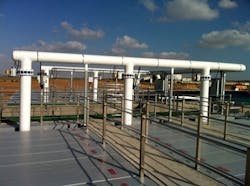Reduction, Recycling, Reuse For Cooling System Makeup
By Colin Frayne
Industry in general, and cooling tower operators specifically, are urged to implement novel strategies to reduce process demands for fresh and potable water, and to expand the use of treated wastewater streams and recycled water as cooling tower makeup.
Cooling system using 100% recycled water.
Cooling systems are generally accepting of a wide diversity of waters and, given some consistency, many industrial streams can be economically recovered and reused as tower makeup. However, recoverable process waters will always require some judicious pretreatment before being recycled for reuse in cooling systems, if only to remove particulates, fats, oils, and greases (FOG), and heavy metals; and provide pH adjustments (say pH 7.0 to 8.5). Suitable candidates may include waters employed for:
- Washing, cleaning, dying, rinsing, melting, quenching, stripping, scrubbing, desalting, plating, surface coatings, fermentation, dust control, process liquors, steam heating and drying, cooking, pasteurization, and domestic purposes.
- Additionally, excess water results from alcohol and spirit distillation, sugar/fish-meal/orange juice evaporator condensates, chemical manufacturing, recovery of fibers and chemicals, straining, filtration, drainage, stormwater storage, etc.
- Also water from high-pressure boiler blowdown, softener and filter rinsing, steam condensate, RO-reject water, acid wash neutralization, electronics wash waters, produced water from oil and gas production, refinery sour water stripper bottoms, and irrigation. Also, treated municipal wastewater, and equalization (EQ) tanks, holding ponds, run-off, mine drainage and tailings.
In turn, cooling tower bleed water might then be reused -- perhaps for detergent/caustic recovery, and cascaded further for, say, vehicle washing, producing recovery/recycling advantages including:
- Reduction in production costs, e.g. recovery of valuable raw materials, less sludge handling and offsite disposals, and reduced water discharge.
- Heat recovery, e.g. passing hot water through a heat exchanger to preheat a process stream and then using the cooled water as cooling tower makeup.
- It’s a good, environmentally conscious thing to do.
Ultimate recycling/reuse plans may be some form of zero liquid discharge (ZLD) system, (which have been used by power generators for several years). These systems rely on optimizing and reconfiguring all process waste streams, with suitable intermediate treatment technologies, usually ending with an RO reject stream that may flow to a brine concentrator, evaporation pond, evaporator, or spray-dry crystallizer; all captured on a material balance flow sheet. Benefits include:
- No water discharge permit and ongoing fees
- No pre-discharge sampling and testing
Recycling/reuse has, of course, been recognized and exploited for many years. However, obvious, incremental and easier water reuse projects for cooling water makeup have generally already been implemented, so today’s projects must, of necessity, be more ambitious, far-reaching, and well-planned.
Water savings in cooling towers come mostly from operating at high cycles of concentration (COC); defined as the ratio of concentration of total dissolved solids (TDS) in recirculating water to that of make-up water. However, because operating at high COC with reuse water may result in unacceptable discharge levels of heavy metals, ammonia, total organic carbon (TOC) or pH, it is necessary to take into account water quality standards regulations. Thus, plans for using even relatively good quality waters may demand critically optimizing and reconfiguring energy input requirements and process waste streams (via pinch analysis), and require intermediate treatment technologies similar to a ZLD scheme.
In general, consideration of a recovered waste stream for reuse as cooling tower makeup requires:
1. Understanding process flows and materials balance, plus adequate reuse stream volumes of reasonably consistent quality.
2. Understanding current recirculating cooling water and makeup water chemistry, testing parameters and operating conditions, limitations and costs; as a comparison against reuse sources.
3. Understanding the proposed recycled water in terms of chemical/physical characteristics, including pH, temperature, calcium, magnesium, alkalinity, silica, suspended solids, chlorides, sulfates, and the presence of potentially undesirable constituents, such as FOG, solvents, ammonia, soluble/insoluble iron, or heavy metals. Also, a 5-day biochemical oxygen demand (BOD5), chemical oxygen demand (COD) or total organic carbon (TOC).
4. Interpretation of data, in order to identify which contaminants are likely to provide limiting factors regarding deposition, fouling, or corrosion of materials of construction (such as copper, steel, heat-exchanger alloys, or concrete), and thereby impact chemical treatment programs, COC, bleed discharge volumes, and ongoing costs. Contaminant limits are:
- Alkalinity: Typically limit to 500 to 600 mg/L as CaCO3
- Ammonia (NH3): Up to 20 to 40 mg/L can be tolerated if copper content is low, and waterside surfaces are clean.
- BOD: Water with a BOD5 >50 to 60 mg/L may be suitable as make-up.
- Total Hardness: A practical limit is 600 to 1200 mg/L as CaCO3 in the recirculating cooling water
- Chlorides: Chloride is a depassivating ion. Keep as low as possible, based on materials used.
- Iron: Typically, 2.0 mg/L total iron is the maximum acceptable in a cooling system.
- Oil, solvents and hydrocarbons: A problem! Find a way to remove them
5. A robust and economic pretreatment design, providing water to a desired or seable chemical/physical water quality specification that permits, in conjunction with a downstream chemical inhibitor program, as high a COC as practically possible. All without undue risk of fouling, deposition risk or corrosion problems developing - especially to critical heat-exchange components and other materials of construction.
Remember the law of diminishing returns applies – for any specific cooling system, beyond a certain COC number the risks of waterside problems increases greatly as the reward of water savings progressively diminishes. A COC of 4x to 6x is often a good standard; there is seldom any significant benefit in raising COC levels to >10x unless a ZLD system is in place.
Recovered water pretreatment processes under consideration will depend upon the source and type and concentration of contaminants but might be drawn from the following list:
- Alkalinity removal via lime softening, sulfuric acid treatment, or ion-exchange, e.g. strong/weak acid hydrogen cation (SAC/WAC), plus degassing, or strong base chloride anion (SBA)
- Dirt, grit, sand, slime, algae removal using a sand filter, multi-media filter, inclined plate clarifier (e.g. Lamella Gravity Settler), or conventional coagulation/sedimentation/clarification techniques
- Disinfection by UV, ozone, chloramines, chlorine dioxide, bleach, etc.
- FOG, solvent and hydrocarbon removal (e.g. benzene, toluene, xylene – BTX) using coalescers such as American Petroleum Institute (API) separators or corrugated plate interceptors (CPI), or dissolved air flotation (DAF) units. A secondary filtration system may be required, such as bentonite, organoclay, or similar full-flow media filter (e.g. Biomin™), or advanced membrane filtration/absorption process, coupled with a micro-biological extraction reactor. Careful designs are needed, as the rule of thumb is often that 50% of costs are incurred for the first 99% of contaminant removal, with the other 50% being spent on the last 1%.
- Hardness and/or silica removal through hot/cold lime and lime-soda softening or ion-exchange
- Heavy metal removal by use of coagulation and alkaline precipitation, or by carbamates. Also, absorption on waste treatment residues (WTR – a lime based product) or iron-coated olivine (a magnesium-iron silicate) – usually at a neutral to acid pH
- Iron and manganese removal by use of aeration, coagulants, manganese greensand/permanganate techniques, or BIRM™ filters
- VOC’s, organics, ammonia, chlorine, color, turbidity, BOD, and COD removal using air scouring, activated carbon filters, bio-reactors, redox, or traditional activated sludge methods.
- Wide-spectrum contaminant removal. In addition to the above, various membrane techniques (e.g. microfiltration, EDI, RO) may be employed, either as stand-alone processes, combined with deionization (DI), or as part of more complex pretreatment arrangements to remove oils and organics, etc.
High COC results in water savings, and the example in Table 1 shows, the decrease in makeup requirements with increasing COC, for a cooling system generating 50,000 gal/day of evaporation.
About the author: Colin Frayne, CSci, CChem, CEnv, CWEM, FRSC, MCIWEM, FICorr, MWMSoc (UK), CWT (USA), is by original training, an industrial chemist, corrosion engineer and environmental scientist. He has worked in all types of industry for 45 years, lived in half a dozen countries on four continents, worked in over 50, and now resides in Georgia. He is a technical author, lecturer, and industry consultant and can be contacted at [email protected].


